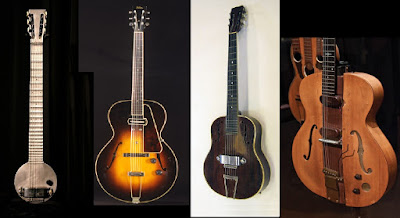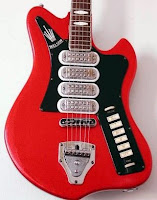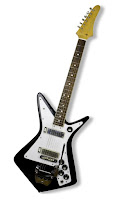 |
| Frying Pan - Gibson ES-150 - Ro-Pt-In Electric - Les Paul's "Log |
 |
| Andres Segovia |
I recall watching a video of Andre Segovia in which he described by playing closer and farther away from the instruments bridge, one could change the timbre of the guitar to give it a more bright or mellow sound.
 |
| Maestro Fuzz Tone |
Guitar tone-shaping pedals came about in the mid 1960’s and by 2016 have evolved into devices that make your guitar sound like an altogether different instrument.
 |
| Roland G202 Guitar and GR500 Synth |
Electronics companies have also introduced guitar synthesizers, that essentially use the guitar as a controller that is connected to a sound producing device.
 |
| 1963 Welson Guitar |
But before all of these pedals and synthesizers came into vogue, guitar manufacturers and designers were attempting to get alter the guitars tone by using some pretty zany pickup designs, lots of pickups, and unusual placement.
Some of these designs worked and some were just plain bizarre.
 |
| 1950 Broadcaster |
Probably the most well known is Leo Fender’s slanted pickup placement on the Fender Esquire, Telecaster, Broadcaster, Stratocaster, Duo-sonic, Bullet, and Mustang. I honestly do not think the treble is enhanced that greatly by slanting the pickup, however it does look cool.
 |
| 1950 Fender Champion Steel |
This was what Leo had been doing on his steel guitars and he was doing a good job of building and selling them.
 |
| 1940 Gibson ES-300N |
 |
| 1941 Gibson ES-300N |
A year later the pickup was redesigned into a much shorter version on the ES-300 that was placed just in front of the bridge.
The guitar craze reached epic proportions in the mid 1960’s. This was after the British Invasion that affected not just the United States, but Europe as well.
 |
| 1960's Hagstrom I |
Countless youngsters wanting to be the next big music group went out and purchased a guitar or bass. Businesses were importing a lot of instruments not just from Japan and Asia, but from Germany, Sweden, Russia, Norway and other European countries. So designers were getting creative with the pickups.
 |
| 1960's Framus Atlantik |
The Framus Atlantik came out around 1966 and was available with either two or three pickups. The body was based on Gibson’s ES design and came with one or two cutaways. The pickups were slanted, but were not parallel. It was definitely not designed by someone with OCD.
 |
| Greco Shrike |
 |
| 1968 Sekova |
The pickups “stair-stepped” downward from the six string pickup by the end of the fretboard to the first string pickup by the bridge. This was meant to be a stereo guitar with the capability of panning an individual string to an individual amplifier.
 |
| Sekova Grecian |
A player would need two amps to properly use this guitar. The biggest problem was the coil in each pickup was not wound enough to get any useful signal. But it looked great on paper. Sekova was a brand name that Kawai Music Company used on some of their guitars at that time.
 |
| 1968 St. Moritz |
This St. Moritz guitar is something of a mystery. It is a stereo guitar and was probably made in Japan by the Fuji Gen Gakki company, although the name conjours up images of Switzerland.
 |
| St. Moritz Stereo |
This was a nice guitar designed to produce stereo sound through two amplifiers and definitely made for playing with a clean sound.
 |
| Wurlitzer Gemini Stereo |
Although the pickups on this guitar appear to look fairly normal, they actually are stereo pickups. This 1966 era guitar was made by a woodworking firm from Neodesha Kansas caled Holman-Woodell for the Wurlitzer Music Company They produced guitars from 1965 through 1968, including the LaBaye 2 x 4 guitar. This is a Wurlitzer Gemini guitar and has Holman-Woodell made Sensi-tone single coil pickups.
Other guitar companies produced stereo guitars. Gibson had produced ES versions of stereo guitar as far back as 1956.
 |
| Ric-O-Sound jacks |
That same year Rickenbacker also implemented "Ric-O-Sound" on many models.
 |
| Ric-O-Sound Box |
This was a stereo configuration circiut, that most performers did not utilize, as it needed a special Ric-O-Sound splitter box.
 |
| Webster with stereo White Falcon |
Gretsch created a stereo guitar for that was designed by Gretsch demonstrator Jimmie Webster back in 1956. It was based on the top-of-the-line White Falcon model and made to be played through a pair of amplifiers.
 |
| Gretsch Dark Eyes stereo guitar |
 |
| Dark Eyes Neck PIckup |
 |
| Fender XII |
The USA was not immune to guitars with unique pickups. The Fender XII (that’s 12 for anyone whose school did not teach Roman numerals), came with four pickups and a 4 way pickup selector. This placement enabled the guitar to be played with the both neck pickups, the lower neck and upper section of the bridge pickups in series, the lower neck and upper section of the bridge pickups in parallel, or both sections of the bridge pickups.
 |
| Fender XII |
Many recording artists preferred the Fender XII since the strings were back-loaded instead of attaching to a trapeze tailpiece, as on a Rickenbacker and each string had an adjustable bridge saddle.
 |
| Fender Maverick |
When the popularity of the electric twelve string guitar waned, Fender cut the bodies, filled in six of the holes in the headstock, added a tremolo tailpiece and called this guitar The Maverick.
 |
| Fender Performer |
The Fender Performer came out in 1985 in an attempt to win over the Heavy Metal players who had gravitated to super-strats. The Performer featured oddly shaped humbucking pickups that slanted upward. The pickups had plastic covers with no exposed pole-pieces.
 |
| Performer Bass |
This instrument came in two models; the Standard and the Elite. Both came with twin single coil pickups, although some models may of had three single coils. The pickup design was rather odd since it was an elongated quadrangle shape. Both instruments were originally made in Japan at a time when Fender had no US based production facility and were designed by John Page.
 |
| 1976 Starcaster |
 |
| Gibson V2 |
 |
| Les Paul Recording |
Les was a pioneer in recording and invented multi-track recording. His technique was called sound-on-sound, which could be accomplished with a tape recorder that had three heads.
Once the first pass was recorded, then laid subsequent passes were laid over over the first track. With high-impedance pickups or microphones the original sounds dissapated after about three or four overdubs. Les discovered the solution was to record with low-impedance pickups and microphones.
 |
| Les Paul Personal |
Gibson produced three different Les Paul Model guitars called the Les Paul Personal, which had an input on the upper bout for a microphone and a goose neck stand, the Les Paul Professional and the Les Paul Recording guitars.
 |
| Les Paul Professonal |
These instruments were equipped with low-impedance pickups for the clarity of their sound, that were meant to plug directly into a recording console, but came with switches and electronics to use with an amplifier. The twin stacked-humbucking pickups were slanted downward.
 |
| '76 Gibson Maurader |
Gibson came up with some unusual designs during their Norlin years. One of these was The Maurader. It was a single cutaway guitar with a 12 1/2” body and a bolt-on neck. This guitar came with a humbucking pickup in the neck position and a single coil blade pickup, encased in epoxy in the bridge position. The bridge pickup slanted downward.
 |
| 1982 Gibson Grabber Bass |
It was a very bright sounding pickup and was placed in an indention in the center of the insturments body. The pickup could “grabbed” by the player and moved forward or backward to make tonal changes.
 |
| Levin aka Goya Guitars |
The electric guitars produced under the Goya brand were actually made in Italy by the Polverini Brothers. One of these models with unusual pickups is the Goya Rangemaster. And though the guitar was produced in Italy, the vibrato system on this instrument was made in Sweden by Hagstrom.
 |
| '66 Goya Rangemaster 105 - 107 |
The controls on the upper bout allow the following pickup combinations. The first is the two neck pickups together, the second switch activates the lower neck pickup and the upper bridge pickup, the third switch turns on the treble side of the neck pickup and the bass side of the bridge pickup and the fourth switch activates both bridge pickups.
 |
| '66 Rangemaster 109 |
The switches on the lower bout control the tone and there is a volume potentiometer.
The Hoshino Gakki company of Japan had been using the brand name Ibanez for some years. They were well known for producing a lot of copies of US made guitars and were eventually sued by Gibson guitars in the Gibson vs Elger action in 1977. It is a fact that Ibanez saw the writing on the wall a few years prior to the lawsuit, because in 1975 the company came up with a very original design called The Ibanez Iceman.
 |
| Artist 2663TC |
The Ibanez Iceman model 2663TC, introduced in 1975 and originally called the Artist model, is quite interesting because it has only one pickup; A triple coil pickup.
 |
| Artist 2663SL |
A similar model called the 2663SL included this same pickup, but the player could slide it to different positions in the body.
 |
| Breeze Bass |
Each pickup, called ARS pickups, has two pole pieces. The bass is an extremely modernistic design.
 |
| Norma EG-200 |
Norma Guitars was the brand name that a United States distributors used on some Teisco guitars. This guitar seems to have a pickup layout similar to the aforementioned Greco guitar, but in reverse.
The switch on the upper bout controls the pickup configuration.
 |
| Tokai Talbo Bass |
The Tokai Company of Japan began making copies of Fender and Gibson guitar around 1977. By 1983 Tokai introduced an aluminum body guitar and bass called The Talbo (Tokai Aluminum Body). The guitar comes with the usual humbucking pickups
 |
| Tokai Talbo Bass |
As always, the links under the pictures take you to the source, while the links in the text take you to further information. Don't miss the link under the Gretsch Dark Eyes guitar.
©UniqueGuitar Publications (text only)







4 comments:
I love this blog. The Westone Rail bass is pretty cool too for a sliding pickup bass - check that one out if you can find one.
You know Jim, I had forgotten about that guitar. Westones were made by Matsumoko and distributed by The St. Louis Music Company. That is a very unique bass, with the pickup sliding on a track.
Thanks,
~Marc
Also just wanted to say I love this blog. Keep going!
Thank you Adam.
~ Marc
Post a Comment